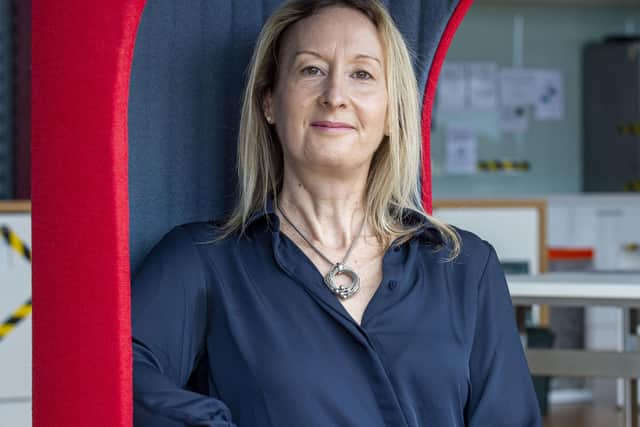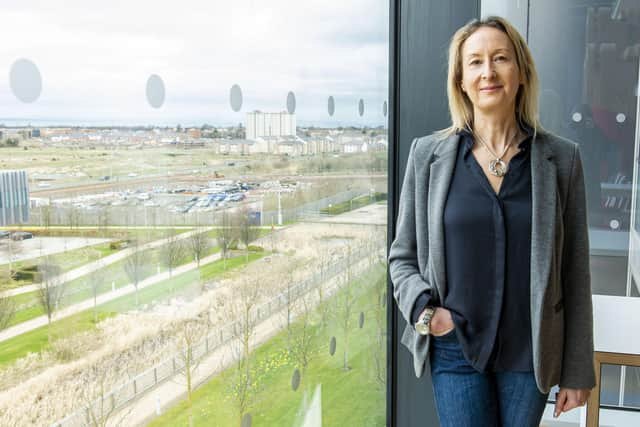The Big Interview: Anna Stamp, interim programme director, Edinburgh BioQuarter
and live on Freeview channel 276
The site in the south-east of the Scottish capital is home to the likes of the Royal Infirmary of Edinburgh Queen’s Medical Research Institute, and Life Sciences Innovation Centre NINE – which is home to more than 25 firms.
Ms Stamp qualified as an architect in 1997, and worked in estates planning and development for several years at the University of Edinburgh before taking on her current role in October 2019. She was hired to lead the transformation of the BioQuarter on behalf of the BioQuarter Partnership, is following in the footsteps of former director Hans Möller, and says she wants to show her children that they have “endless” opportunities. “I am so encouraged by the passion young people have for the environment, fairness and equal rights – and how vocal they are about it compared to my generation.”
Advertisement
Hide AdAdvertisement
Hide AdCan you explain what your role entails and what you aim to achieve?


Edinburgh BioQuarter is one of Scotland’s real success stories. It began its journey in 1997 and has grown to become one of the UK’s leading locations for medical teaching, research and healthcare. Today we are proud to be home to the Royal Infirmary of Edinburgh, the new Royal Hospital for Children and Young People, and the University of Edinburgh’s prestigious Medical School alongside many other successful and ever-growing life sciences businesses.
Activities on-site across BioQuarter have so far generated upwards of £2.7 billion gross value added (GVA) to Scotland’s economy since 2002. There are also now an estimated 8,000 people working or studying here, generating a further £280 million in GVA every year.
We intend to regenerate and accelerate the growth of the site to become a global destination for health innovation and enterprise to create Edinburgh’s £1bn Health Innovation District.
Advertisement
Hide AdAdvertisement
Hide AdOver the coming decades, the district will grow considerably into a new mixed-use neighbourhood. It’s often said that data is the new oil, and it is the lightning rod that links all research and innovation at BioQuarter. Our plans will see the new Usher Institute's Data-Driven Health and Social Care Innovation Hub built at the heart of the site as part of the City Region Deal investment to establish Edinburgh as the data capital of Europe.


The partnership behind BioQuarter (City of Edinburgh Council, NHS Lothian, Scottish Enterprise and the University of Edinburgh) is looking to create a public-private joint venture partnership. We are searching for a new partner, and this is crucial to the delivery of the next chapter for BioQuarter.
I am leading the journey towards this transformation: managing the procurement process as well as developing the masterplan, placemaking, innovation and community strategies that will support the partners’ vision.
The procurement exercise to bring in a private sector partner will officially kick off later this year, with myself and the wider team in the final throes of the pre-procurement phase. We’ve already seen strong interest in the opportunity from major companies across the UK, Europe, North America and Asia.
Advertisement
Hide AdAdvertisement
Hide AdThe successful partner will need to understand our aims to develop an innovation district that brings significant social and economic benefits to Scotland, alongside many community benefits for those who live, work or study at BioQuarter, and in our neighbouring communities such as Craigmillar, Liberton and Moredun.
The BioQuarter is playing a key role in tackling coronavirus, serving as the base for the STOPCOVID research programme – how is this progressing? And to what extent has the pandemic shone a light on the need for innovation and collaboration in healthcare?
The pandemic has focused the lens on the health and life sciences sectors. While innovation and research around Covid have taken precedence within the media, the wider research life cycle has not stopped.
Researchers and clinicians can work alongside each other to tackle global health issues on one site at BioQuarter. One good example is the STOPCOVID project where a team of 100 University of Edinburgh and NHS Lothian respiratory physicians and scientists, led by Professor Kev Dhaliwal, is working at speed on progressing Covid-19 therapies. The team supported drug screening and Covid-19 post-mortem studies to aid the identification of existing and new drugs for re-purposing and testing in a patient experimental medicine platform.
Advertisement
Hide AdAdvertisement
Hide AdThe team has completed its first phase of in-hospital trials and the databases are now being analysed. They are also accelerating technology to deliver and analyse drugs in patients’ lungs, for example.
The project truly spans the breadth of expertise across organisations and institutes based at BioQuarter and was supported to the tune of £2m by the medical research charity LifeArc, based in NINE.
The last 18 months have seen more businesses choosing to base themselves at the BioQuarter, RoslinCT expanding its operations there, and the update of the masterplan, for example. How would you characterise progress over this period and how does it pave the way for the next steps?
We are pleased to have created a setting where spin-outs and start-ups from the University of Edinburgh, from Scotland, and around the world want to base their businesses to grow. The proximity to the university’s research, the teaching hospitals, imaging and trials facilities, and the wider life sciences community provides them with a competitive advantage.
Advertisement
Hide AdAdvertisement
Hide AdOver the past 18 months we have made good progress ensuring that our new place strategy and emerging masterplan meets the evolving needs of people in today’s world. Introducing mixed facilities and residential accommodation is essential as we transition from a science park to innovation district.
This mix will bring a critical mass essential to improving the experience for staff, students and visitors. We currently have around 20 small and medium-sized enterprises based at BioQuarter, and if we get it right we’re looking at nurturing potentially hundreds of health innovation companies.
Your background is in architecture, but you previously worked in estates planning and development at the University of Edinburgh. What led you to join the BioQuarter?
At its core, BioQuarter is a regeneration project – which for any architect is a wonderful venture to be involved in. The chance to create a new neighbourhood of Edinburgh and define its place strategy is a once-in-a-career opportunity and I am proud to have been allowed to lead it. The creation of a successful place is seen as the critical aspect to BioQuarter's success and to ensure that our innovation district functions to its full potential.
Advertisement
Hide AdAdvertisement
Hide AdThe place strategy will transition BioQuarter into a new neighbourhood of Edinburgh – an attractive, welcoming urban quarter for people to live, learn, work, play, relax and discover. Shops, cafés, a hotel, nursery and residential homes will sit alongside the state-of-the-art innovation facilities, creating a lively environment that promotes the health and wellbeing of its community.
As an architect, it is particularly important to me that we also create a location that leads on environmental sustainability and carbon reduction, and integrates into the surrounding communities and enhances their wellbeing as well as offering new job and living opportunities.
What is the biggest challenge you face in your role?
Right now, the biggest obstacle is that many of our stakeholders are responding to the pandemic, in terms of the immediate response to healthcare delivery and teaching.
It is essential that people be involved and informed of our plans but, as is quite understandable, priorities have been more focused on the here and now, and not the long term. This will change as we emerge from the pandemic and we must keep focused. The plans we create today will affect the next 30 to 40 years for Edinburgh and Scotland – it is a massive opportunity, and one we must make sure we harness.
Advertisement
Hide AdAdvertisement
Hide AdThe Life Sciences Strategy for Scotland aims to grow the industrial turnover of the sector to £8bn by 2025 – a target it is expected to exceed. How can the BioQuarter contribute to this and what would you like it to look like at that stage?
By 2025, we will be well into BioQuarter’s transformation – ensuring there is more health innovation accommodation to allow further growth and expansion for businesses and organisations based at the site, and for those that will join us here. BioQuarter is well-placed to collaborate with other science parks and universities across Scotland, to support a wider life sciences strategy that benefits the people of Edinburgh and Scotland by connecting people in a more concerted way.
By this point, the Usher Institute building will be open on-site and I fully expect that this will be one of the key drivers of growth for Edinburgh and Scotland’s economy. The Usher Institute’s expansion at the heart of BioQuarter has the opportunity to make global impacts through research, teaching and the growth of companies that are both founded locally and as inward investments into the site.
A message from the Editor:
Thank you for reading this article. We're more reliant on your support than ever as the shift in consumer habits brought about by coronavirus impacts our advertisers.
If you haven't already, please consider supporting our trusted, fact-checked journalism by taking out a digital subscription.
Comment Guidelines
National World encourages reader discussion on our stories. User feedback, insights and back-and-forth exchanges add a rich layer of context to reporting. Please review our Community Guidelines before commenting.
